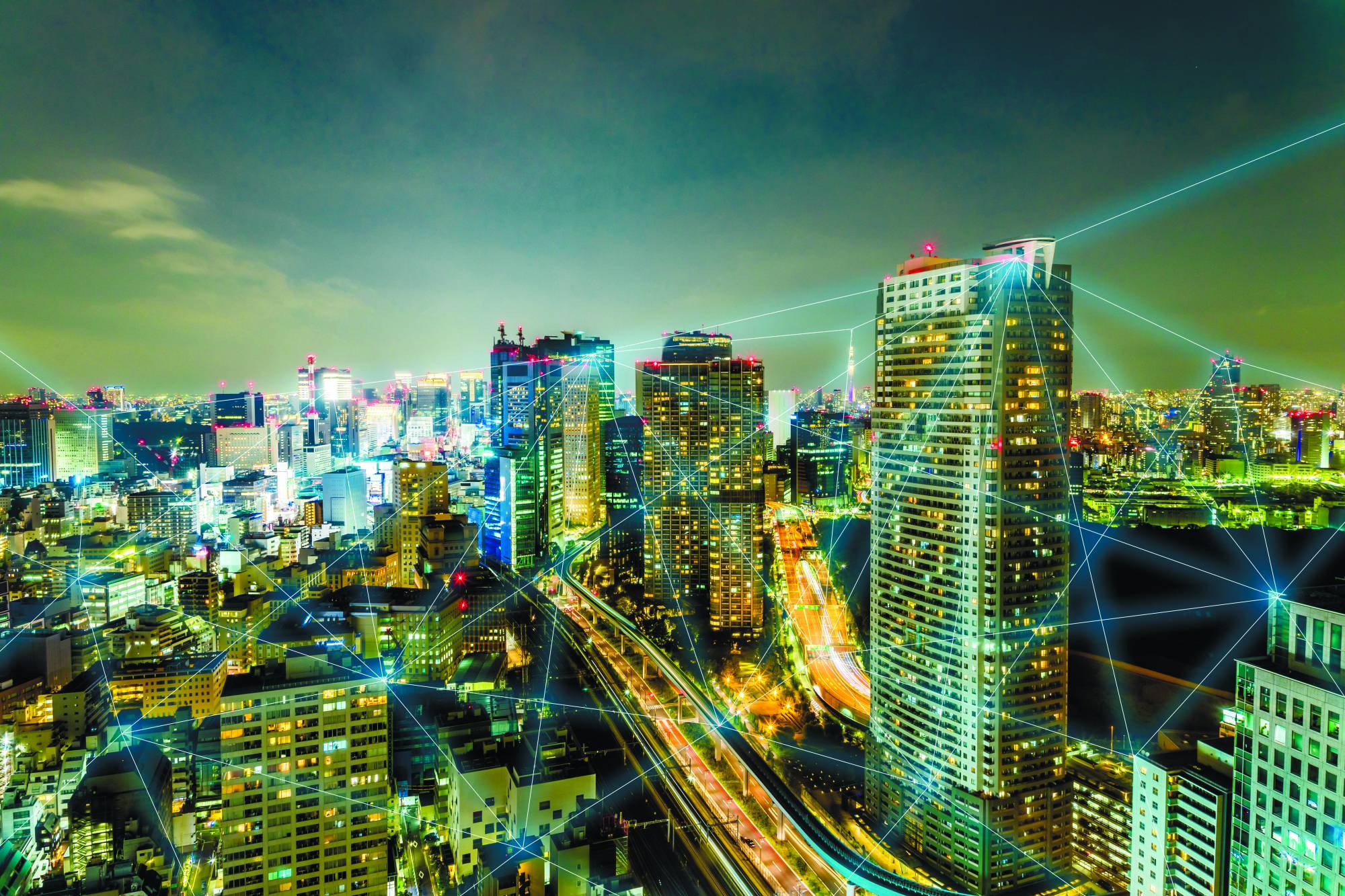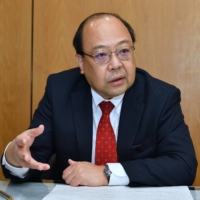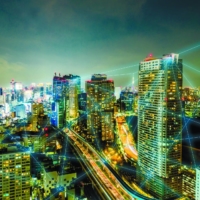About a year has passed since Japan’s first commercial 5G mobile communications service was launched. The Ministry of Internal Affairs and Communications has announced a target of increasing the number of base stations to 280,000 by the end of March 2024 and is promoting further development of the communications infrastructure.
Tests are underway to verify remote control and remote medical care, which 5G is expected to make possible, and use of the technology is steadily growing.
On the other hand, Yasuhiko Taniwaki, vice minister for policy coordination at the ministry, points out that Japan has many hurdles to overcome in areas ranging from cybersecurity to the nurturing of IT human resources. In an interview with The Japan Times, Taniwaki discussed the status of 5G in Japan and the concept of “Beyond 5G.”
“In Japan, about 99% of households are under the coverage of fiber-optic links, which makes it one of the leading countries in the world. The ratio for 4G service coverage has reached 99%, and the number of people residing in areas not covered by the network has declined to 13,000,” Taniwaki said. “You can speed up the development of 5G infrastructure by using the 4G infrastructure, that is to say, by replacing 4G base stations with 5G base stations. So Japan has a developed fiber-optic infrastructure and a high 4G service coverage ratio, which gives it an advantage over other countries in terms of developing a 5G network.’’
The ministry’s goal is to have base stations installed in half of its grid of 4,500 10 km-by-10 km cells covering the nation. It initially aimed to have 70,000 base stations by the end of March 2024, but quadrupled that to 280,000 in the same time frame in the “Master Plan 3.0 on the Regional Development of ICT Infrastructure” that the ministry released in December last year. ICT stands for information and communication technology.
“We raised the figure because mobile carriers’ capital expenditure plans indicate they will each spend about ¥2 trillion over the next decade, and the development of fiber-optic infrastructure has advanced to a significant degree,” Taniwaki said. “Of course, the government needs to support them. Under a tax incentive program to promote 5G investment, they are entitled to a generous 15% tax credit. In disadvantaged areas, such as sparsely populated areas, a government support program is available for base station installation projects.”
5G networks are divided into public networks developed and operated by mobile carriers and local networks that nontelecommunications companies or local governments set up within their buildings or premises for their exclusive use. The latter, for example, is used for remote control operations in factories. Projects to test such networks were started in 2020, and 19 such projects are currently underway, according to Taniwaki.
“These include projects that test remote monitoring and process automation at factories and automation of farm work using drones or robots. We believe (local 5G networks) are useful in telemedicine using high-resolution 4K video and counterdisaster measures,” Taniwaki said. “If you monitor the state of rivers using 4K video and artificial intelligence, you can learn about the swelling of a river in a more granular way, which makes it easier to take measures. The ministry aims to lead the launch of such projects and disseminate information on successful examples so that such applications can be used more widely in other areas.”
The coronavirus pandemic began just as Japan kicked off 5G services last year. In April, a state of emergency was declared across Japan, restricting the movement of people, and that had a serious impact on the economy. At the same time, companies began adapting to telecommuting quickly and widely and digitalization was promoted.
“The coronavirus has affected the field of telecommunications. More people learned that telecommuting, remote education and telemedicine can help maintain socioeconomic activities without requiring contact between people,” Taniwaki said. “We researched passenger traffic at key railway stations in cooperation with mobile carriers. This was very useful. It sent a message to people that they must refrain from leaving home, by gathering data using digital technology and showing it to the general public. The coronavirus pandemic has increased the importance of developing 5G infrastructure.”
Digitization and digitalization
5G aims to digitalize every single industry. It will bring about change in industries in society by helping them accumulate and analyze huge amounts of data. Taniwaki, however, predicts that 5G technology will make industrial classification obsolete rather than bring about changes in the primary, secondary and tertiary industries individually. For example, by linking a supply chain via digital data, the three levels in it — farming, processing and retail — will all be linked together.
Taniwaki also believes society will become data-driven.
“It’s increasingly becoming important to decide how to use data. You collect data from innumerable sensors and analyze the big data gathered, using artificial intelligence. Then you resolve issues faced by society by using these analyses. It’s like society merging with the cyberworld,” Taniwaki said.
The three advantages of 5G networks are high speed and large bandwidth, low latency and simultaneous connectivity for a large number of devices. The first enables you to send large amounts of 4K data video, for example, in an instant. Low latency is indispensable for achieving self-driving vehicles and remote surgery. The real-time transmission of data will help prevent traffic accidents in self-driving cars and allow risky types of surgery to be conducted from a distance.
Simultaneous connectivity for multiple devices enables data collection from a large number of sensors. This makes it possible to enhance the efficiency of urban management, which will play a significant role in realizing smart cities.
“We hear people talk a lot about digitalization and digital transformation these days. In traditional digitalization, digital technology was the tool. It meant, for example, introducing such technology in areas that don’t have PCs, which is called digitization,” Taniwaki said.
“What is needed now is to link data across boundaries of different fields. The creation of convenience by doing this is what is meant by digitalization. It links data that was previously used within individual fields, such as government administration, health care and education, using data systems. This can be compared to multiple living cells becoming connected with each other to form a biological system. We call it the system of systems.
“This will create a society in which what was invisible becomes visible. What remained the discovery of issues using data in coarse granularity will develop into resolution of issues, and what remained the analysis of the past will develop into predictions of the future. What was partial optimization will shift into total optimization.”
Communication environment
To put the three features of 5G to maximum use, it is necessary to enhance the environment in areas other than infrastructure. Taniwaki points to the handling of personal information. Data has become concentrated at the platformers, represented by companies such as Google, Apple, Facebook and Amazon, and, in Japan, at Rakuten, Inc. and Yahoo Japan Corp. Taniwaki says we should think of how platformers should be.
It is also important to strike the right balance between network neutrality and priorities. The use of telecommunication services should be equitable, but a degree of priority should be granted for its use in self-driving and remote surgery.
The development of telecommunications infrastructure is not a matter for Japan only. There is also the need to develop an international telecommunications environment.
“There’s no national border in cyberspace. Data travels freely across borders,” Taniwaki said. “In information security, the three key elements are confidentiality, integrity and availability of data. Countries must negotiate international rules to ensure these are maintained. The Japanese government has proposed DFFT, which stands for data free flow with trust. It calls for encouraging the distribution of data in ways that inspire trust. So there is also the need to develop an international telecommunications environment for that.” Security and human resources
Taniwaki was deputy director-general of the Cabinet Secretariat’s National Center of Incident Readiness and Strategy for Cybersecurity, also known as NISC, and cybersecurity is his specialty.
He says there is the risk that, in 5G networks, cyberthreats in one field can easily spill over to other areas.
“Systemic risk becomes greater in a system of systems. As multiple or large numbers of companies, instead of just one company, are involved, it is important to take measures to mitigate supply chain risk,” Taniwaki said. “Cyberattacks have become complex and cunning. A perimeter defense put up at the entrance of a system used to be one typical measure, but a new tactic, so-called zero-trust architecture, is being used. It assumes attackers can breach the system, but instead of completely trusting users, it requires identification each time a transaction is conducted.
“And then there’s the issue of a significant shortage of human resources for information security. In Japan, IT human resources are concentrated in the IT industry. Considering our future society, other industries must have IT experts.”
The communications ministry is running a program called Cyder to nurture IT human resources at its National Cyber Training Center, which was established within the National Institute of Information and Communications Technology (NICT). Under the program, drills are conducted nationwide to shed light on the causes of and take countermeasures against cyberattacks. There’s also the SecHack365 program that focuses on spotting young IT talent under the age of 25.
Beyond 5G
Commercial 5G services have only begun, but research efforts on a next-generation telecommunications system are already underway. The communications ministry calls it Beyond 5G. The technology aims to achieve 10 to 100 times the speed and bandwidth of 5G and reduce network power consumption, which is expected to increase in line with the growth of 5G.
Since mobile phone systems shift to the next generation every 10 years, according to Taniwaki, preparations had to start in 2020 to establish the next advance in telecommunications technology by 2030.
The ministry released a “Beyond 5G promotion strategy” in June. Research and development, standardization of intellectual property and 5G proliferation strategy form the three pillars of this strategy. R&D, which will be conducted over the next five years, aims to develop the basic technologies. For this, the government will earmark ¥30 billion for NICT. Research and development will be conducted over the next five years based on a ¥100 billion budget.
The aim of standardizing intellectual property is to help essential patents that must be used for system development to attain a large share of the market. According to Taniwaki, essential patents granted to Japanese companies in 5G represented only several percent of the market. The ministry aims to achieve a 10% share by working with other countries on Beyond 5G.
“We aim to produce R&D achievements in about five years and then standardize intellectual properties. There’s also a strategy to implement networks in society, so the year 2030 will arrive in a flash. That’s why we must start now,” Taniwaki said. “What the Beyond 5G technology can realize is, for example, a system that enables users to have a realistic experience on the spot, using avatars and robots. Other examples would be a system in which objects control each other to optimize traffic flow and an autonomous system that doesn’t require human intervention. This may make it possible to create a fail-safe structure that automatically keeps a network functioning even when communication is disrupted, by introducing alternative routes and capacity.
“A Japan Science and Technology Agency report estimates that communication traffic will grow to 36 times the level in 2016 by 2030. In proportion, power consumption will also reach 36 times current levels. That represents about 150% of the current total power consumption in Japan,” Taniwaki said. “This is why the Beyond 5G promotion strategy has set the target of reducing power consumption to a hundredth of the current levels. Reducing power consumption leads to greening.
Greening here means the promotion of “green by digital,” or using digital technology to promote greening. An example is a smart city in which traffic congestion is mitigated. There’s also “green of digital.” You reduce power consumption using the Beyond 5G technology. We regard them as the two wheels on an axis on which we’ll move forward.”






